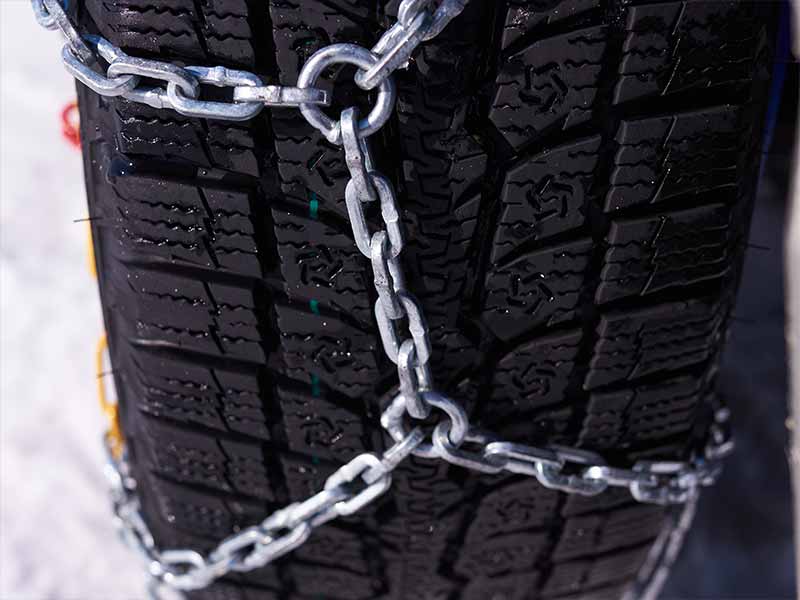Have you ever found yourself staring at a snowy road, wondering if two snow chains are enough for your 2-wheel drive vehicle, or if you need more? You’re not alone. Many drivers face this dilemma, especially as winter approaches and road conditions become more challenging.
How Many Snow Chains Do I Need For 2 Wheel Drive?
For most 2-wheel drive vehicles, two snow chains are typically sufficient – placed on the drive wheels, which are the front wheels for FWD vehicles and the rear wheels for RWD vehicles.
In severe conditions or for better control, four can offer extra stability and safety.
In this article, you’ll find detailed insights into understanding your vehicle’s drive type, the basics of snow chains, how many you need, how to install them correctly, and when to use them.
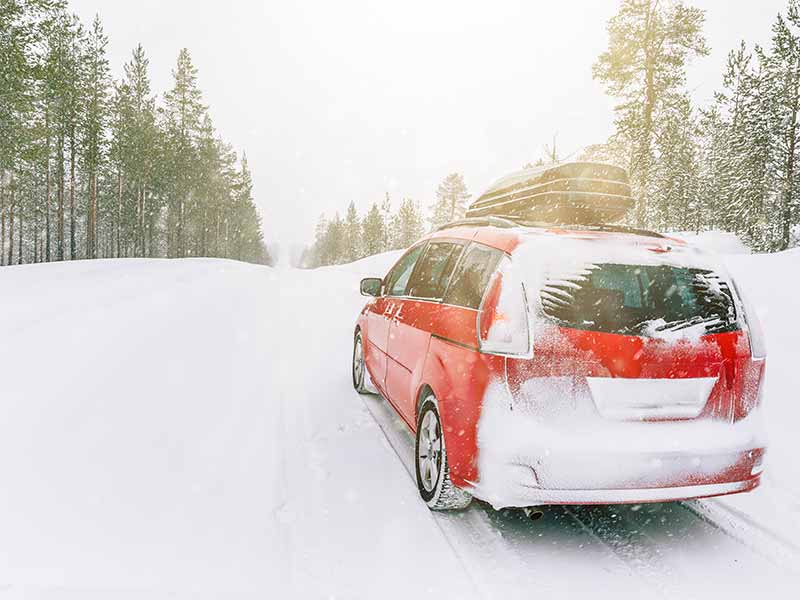
Understanding Your Vehicle’s Drive Type
I’ve learned that each type of vehicle responds differently to snowy and icy roads. I’ve seen many drivers overlook this aspect, leading to inadequate preparation for winter driving.
Whether you’re driving a FWD, RWD, or 4WD vehicle, knowing where to apply snow chains can make a significant difference in your driving experience and safety during winter.
Front Wheel Drive (FWD)
- Characteristics: In FWD vehicles, the front wheels do the work of moving the car forward.
- Handling in Snow: These cars usually perform better in snowy conditions. The engine’s weight over the front wheels helps increase traction.
- Applying Snow Chains: For FWD vehicles, you should place snow chains on the front tires. This is because these tires are responsible for both steering and propelling the car.
Rear Wheel Drive (RWD)
- Characteristics: RWD vehicles rely on their rear wheels for movement.
- Handling in Snow: They can be more challenging to handle in snow. The rear wheels, which provide the driving force, have less weight over them, leading to reduced traction.
- Applying Snow Chains: In RWD cars, it’s important to put chains on the rear tires. This helps in gaining better traction at the back, where it’s needed most.
Four Wheel Drive (4WD)
- Characteristics: 4WD vehicles can distribute power to all four wheels.
- Handling in Snow: Generally, these vehicles are better equipped for snowy conditions. However, they can still benefit from snow chains in more severe situations.
- Applying Snow Chains: The need for chains on all four tires depends on the severity of the conditions. Often, equipping either the front or rear tires with chains is sufficient.
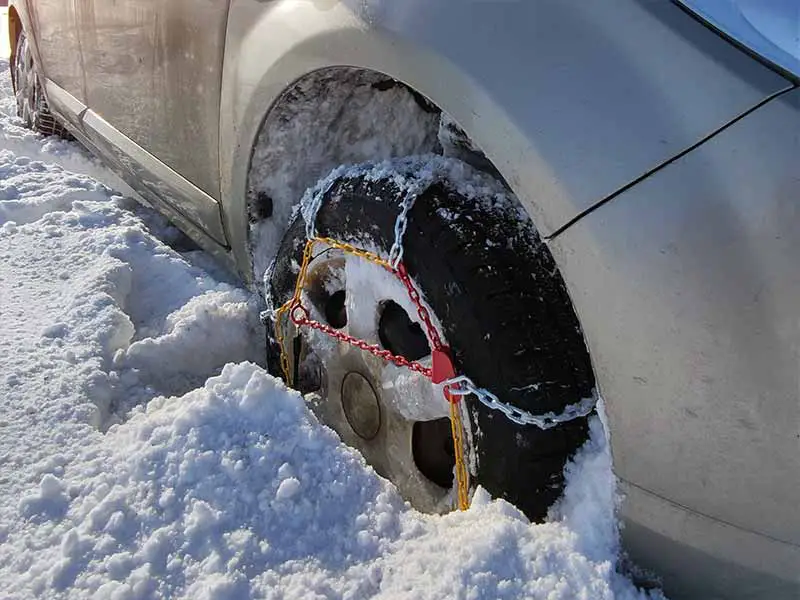
The Basics of Snow Chains
Snow chains, or tire chains, are essential tools that provide your vehicle with the extra grip and stability needed on snowy and icy roads.
In my experience, drivers who are well-informed about their snow chains – from choosing the right type and size to understanding when and how to use them – tend to have a safer and more confident driving experience in winter conditions. Remember, it’s not just about having the chains; it’s about knowing how to use them effectively.
Let’s break down the basics to help you understand and choose the right snow chains for your vehicle.
Choosing the Correct Size
- Importance of Fit: It’s crucial to select chains that properly fit your tires. Incorrectly sized chains can be ineffective, damage your vehicle, and pose safety risks.
- How to Find the Right Size: You can find the correct size by checking your tire’s sidewall for numbers indicating size, such as ‘225/75R16’. Ensure the chains you select are designed for these measurements.
Types of Snow Chains
- Traditional Chains: These are made of metal and designed to provide maximum traction. They’re ideal for heavy snow and more rugged conditions.
- Cable Chains: Lighter and easier to install, cable chains are suitable for lighter snow and less severe conditions. They’re also a good choice for vehicles with limited clearance around the tires.
Installation Tips
- Practice Beforehand: I always advise practicing the installation of snow chains at home, in a safe and comfortable environment, before you actually need them.
- Follow Instructions: Each type of chain will come with its own set of instructions. It’s important to follow these closely to ensure safe and effective use.
When to Use Snow Chains
Understanding when to use snow chains is as important as knowing how to install them. Generally, you should consider using snow chains when:
- Heavy Snowfall: In conditions where the roads are covered in deep snow.
- Icy Roads: Especially in situations where winter tires alone might not provide enough traction.
- Mandatory Requirements: Some regions have laws requiring snow chains under certain conditions.
For a deeper understanding of when to use snow chains versus other options like snow tires, the article on Snow Tires vs. Chains can be a valuable resource. It provides insights into making the best choice for your specific driving conditions.
How Many Snow Chains Do You Need?
In my experience, the decision on how many snow chains to use comes down to a balance of safety, vehicle type, and driving conditions. The answer isn’t always straightforward, as it depends on your vehicle type and the conditions you’re driving in.
Let’s break this down to provide a clear understanding.
Snow Chains for Front Wheel Drive Vehicles
- Typical Requirement: For most front wheel drive (FWD) vehicles, you’ll need two snow chains.
- Placement: These chains should be placed on the front tires, as these are the tires that your car uses to move and steer.
- Reasoning: Since FWD vehicles rely on the front tires for both propulsion and steering, having chains on these tires provides the necessary traction for moving forward and controlling the vehicle on snowy or icy roads.
Snow Chains for Rear Wheel Drive Vehicles
- Typical Requirement: Similarly, for rear wheel drive (RWD) vehicles, two snow chains are usually sufficient.
- Placement: These chains should be placed on the rear tires, which are responsible for moving the vehicle.
- Reasoning: In RWD vehicles, the rear tires need extra traction to prevent the back of the car from sliding out, especially during acceleration.
Considering Four Snow Chains
- Enhanced Traction: While two chains are often enough, using four snow chains can provide additional stability and traction, especially in severe weather conditions.
- Balanced Handling: Four chains can help balance the vehicle’s handling, making it easier to control.
Factors to Consider
- Driving Conditions: If you’re driving in extremely snowy or icy conditions, using four chains might be more beneficial.
- Vehicle Handling: Some drivers prefer the feel of chains on all tires as it can provide a more balanced and predictable driving experience.
- Manufacturer’s Recommendations: Always check your vehicle’s manual for any specific recommendations or restrictions regarding the use of snow chains.
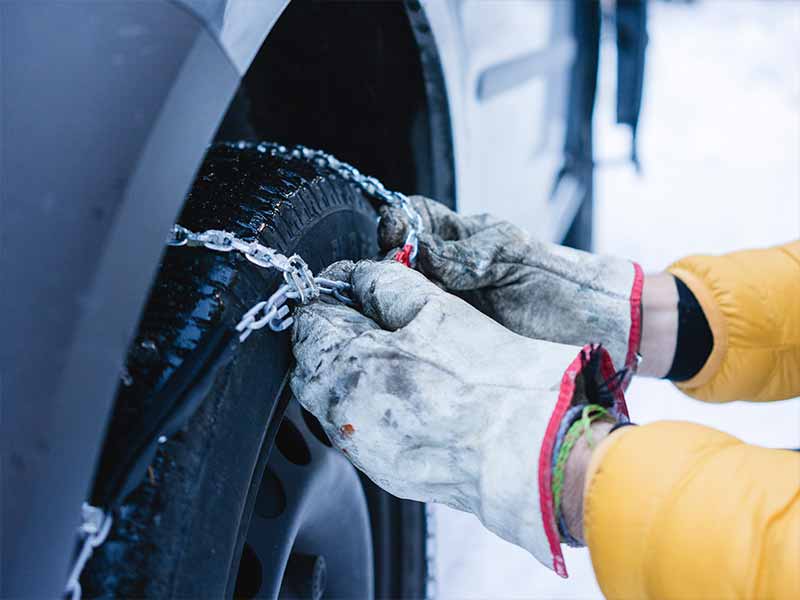
Installation of Snow Chains
Many drivers struggle with the installation of snow chains. It’s important to know how to properly install them on your care or truck, whether it’s front wheel drive (FWD) or rear wheel drive (RWD). Let’s go through the steps to ensure a safe and correct installation.
How To Put On Snow Chains – Step-By-Step
- Preparation: Before you start, make sure your vehicle is parked safely and on a level surface. Apply the parking brake for added safety.
- Lay Out the Chains: Spread the chains out near the tires to ensure there are no tangles or twists.
- Positioning the Vehicle: For RWD vehicles, you might need to move the car slightly to properly position the chains around the tires.
- Drape Over the Tire: Carefully drape the chains over the top of the front tires, making sure they are centered.
- Secure the Chains: Follow the manufacturer’s instructions to secure the chains. This usually involves connecting hooks or clasps at the back of the tire, then doing the same at the front.
- Tighten and Retighten: After securing the chains, drive forward a few feet, then stop and retighten them. This step is crucial for ensuring the chains are snug and won’t come loose.
General Tips for Snow Chain Installation
- Practice Makes Perfect: I always recommend practicing the installation at home before you find yourself in a snowy situation.
- Wear Gloves: Always wear gloves to protect your hands from cold and injury.
- Follow Instructions: Each set of chains might have slightly different instructions, so it’s important to follow the specific guide for your chains.
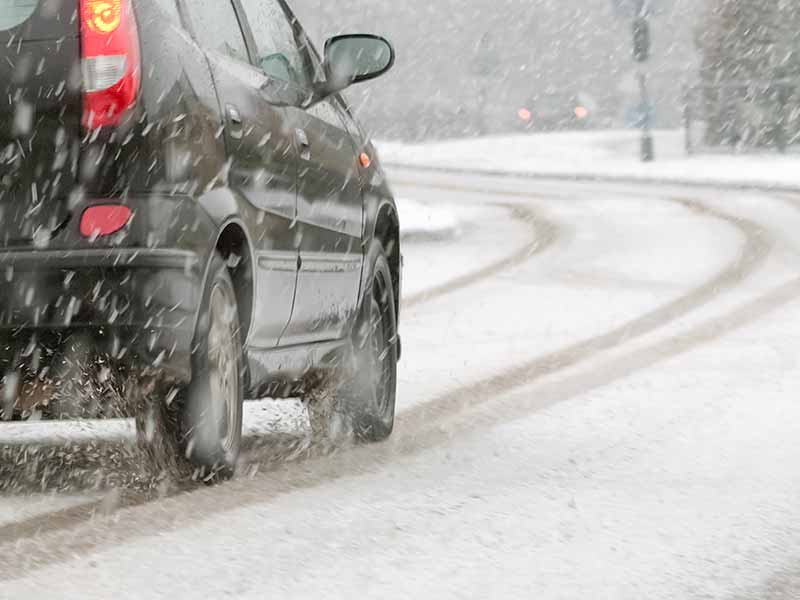
Safety Tips and Maintenance for Snow Chains
I can’t emphasize enough the importance of proper safety measures and maintenance when it comes to using snow chains. Let’s dive into some essential tips to ensure your snow chains serve you well and keep you safe on the road.
Regular Inspection and Maintenance
- Before Use: Always inspect your chains for any signs of wear, tear, or damage before you put them on your tires. This includes checking for broken links, rust, or any other defects.
- After Use: After removing the chains, it’s important to clean them of any snow, ice, or debris. Let them dry out completely before storing to prevent rust.
Correct Storage
- Dry Environment: Store your snow chains in a dry and cool place. Moisture can lead to rust, which weakens the chains over time.
- Proper Packaging: Keep them in a bag or container that protects them from dirt and moisture.
Driving with Snow Chains
- Reduced Speed: It’s crucial to drive slowly when using snow chains – not exceeding 30 mph (50 km/h) is a good rule of thumb.
- Smooth Maneuvers: Avoid sudden accelerations, stops, or sharp turns. Smooth, gradual movements are key to maintaining control and preventing chain damage.
Knowing When to Remove Them
- Road Conditions: Remove the chains as soon as you’re driving on clear roads again. Driving with chains on bare pavement can damage both the chains and the road surface.
- Regular Checks: If you’re on a long journey, periodically stop to check the chains’ condition and tightness.
Resources
Below are some links you may find helpful when learning about tires:
- Winter driving tips – National Highway Traffic Safety Administration
- How to put on snow chains and why you really should use them – The Washington Post
Final Thoughts
The key is to understand your vehicle’s drive type and choose the appropriate snow chains. Two chains are often enough for 2WD vehicles, but in severe conditions, four can offer extra stability.
Proper installation and knowing when to use them are just as crucial as the chains themselves. Regular maintenance and adherence to safety guidelines will ensure your snow chains are always ready to perform when you need them.
Good luck and happy motoring.
